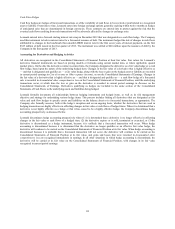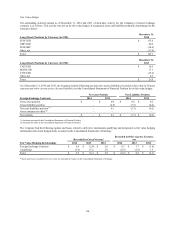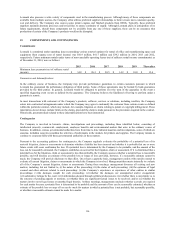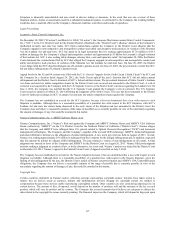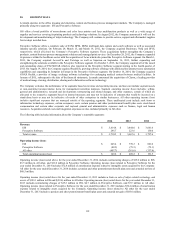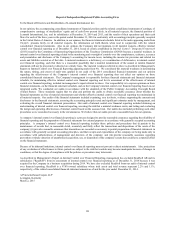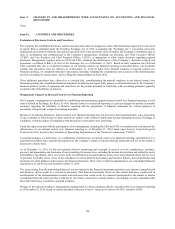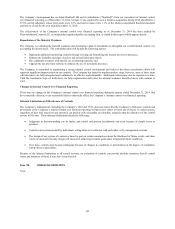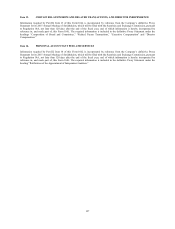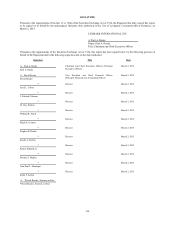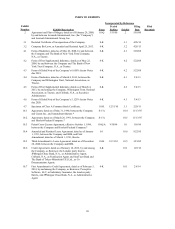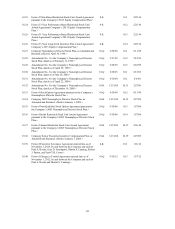Lexmark 2014 Annual Report Download - page 127
Download and view the complete annual report
Please find page 127 of the 2014 Lexmark annual report below. You can navigate through the pages in the report by either clicking on the pages listed below, or by using the keyword search tool below to find specific information within the annual report.Report of Independent Registered Public Accounting Firm
To the Board of Directors and Stockholders of Lexmark International, Inc.:
In our opinion, the accompanying consolidated statements of financial position and the related consolidated statements of earnings, of
comprehensive earnings, of stockholders’ equity and of cash flows present fairly, in all material respects, the financial position of
Lexmark International, Inc. and its subsidiaries at December 31, 2014 and 2013, and the results of their operations and their cash
flows for each of the three years in the period ended December 31, 2014 in conformity with accounting principles generally accepted
in the United States of America. In addition, in our opinion, the financial statement schedule listed in the index appearing under Item
15(a)(2) presents fairly, in all material respects, the information set forth therein when read in conjunction with the related
consolidated financial statements. Also in our opinion, the Company did not maintain, in all material respects, effective internal
control over financial reporting as of December 31, 2014, based on criteria established in Internal Control - Integrated Framework
(2013) issued by the Committee of Sponsoring Organizations of the Treadway Commission (COSO) because a material weakness in
internal control over financial reporting related to the monitoring and oversight of controls over the completeness, existence, accuracy
and presentation and disclosure of the Company’s accounting for income taxes, including the income tax provision and related tax
assets and liabilities existed as of that date. A material weakness is a deficiency, or a combination of deficiencies, in internal control
over financial reporting, such that there is a reasonable possibility that a material misstatement of the annual or interim financial
statements will not be prevented or detected on a timely basis. The material weakness referred to above is described in Management's
Report on Internal Control over Financial Reporting appearing under Item 9A. We considered this material weakness in determining
the nature, timing, and extent of audit tests applied in our audit of the 2014 consolidated financial statements and our opinion
regarding the effectiveness of the Company’s internal control over financial reporting does not affect our opinion on those
consolidated financial statements. The Company's management is responsible for these financial statements and financial statement
schedule, for maintaining effective internal control over financial reporting and for its assessment of the effectiveness of internal
control over financial reporting, included in management’s report referred to above. Our responsibility is to express opinions on these
financial statements, on the financial statement schedule, and on the Company's internal control over financial reporting based on our
integrated audits. We conducted our audits in accordance with the standards of the Public Company Accounting Oversight Board
(United States). Those standards require that we plan and perform the audits to obtain reasonable assurance about whether the
financial statements are free of material misstatement and whether effective internal control over financial reporting was maintained in
all material respects. Our audits of the financial statements included examining, on a test basis, evidence supporting the amounts and
disclosures in the financial statements, assessing the accounting principles used and significant estimates made by management, and
evaluating the overall financial statement presentation. Our audit of internal control over financial reporting included obtaining an
understanding of internal control over financial reporting, assessing the risk that a material weakness exists, and testing and evaluating
the design and operating effectiveness of internal control based on the assessed risk. Our audits also included performing such other
procedures as we considered necessary in the circumstances. We believe that our audits provide a reasonable basis for our opinions.
A company’s internal control over financial reporting is a process designed to provide reasonable assurance regarding the reliability of
financial reporting and the preparation of financial statements for external purposes in accordance with generally accepted accounting
principles. A company’s internal control over financial reporting includes those policies and procedures that (i) pertain to the
maintenance of records that, in reasonable detail, accurately and fairly reflect the transactions and dispositions of the assets of the
company; (ii) provide reasonable assurance that transactions are recorded as necessary to permit preparation of financial statements in
accordance with generally accepted accounting principles, and that receipts and expenditures of the company are being made only in
accordance with authorizations of management and directors of the company; and (iii) provide reasonable assurance regarding
prevention or timely detection of unauthorized acquisition, use, or disposition of the company’s assets that could have a material effect
on the financial statements.
Because of its inherent limitations, internal control over financial reporting may not prevent or detect misstatements. Also, projections
of any evaluation of effectiveness to future periods are subject to the risk that controls may become inadequate because of changes in
conditions, or that the degree of compliance with the policies or procedures may deteriorate.
As described in Management’s Report on Internal Control over Financial Reporting, management has excluded ReadSoft AB and its
subsidiaries ("ReadSoft") from its assessment of internal control over financial reporting as of December 31, 2014 because it was
acquired by the Company in a business acquisition during 2014. We have also excluded ReadSoft from our audit of internal control
over financial reporting. ReadSoft is a 97.8%-owned subsidiary whose total assets and total revenue represent 2.2% and 1.1%,
respectively, of the related consolidated financial statement amounts as of and for the year ended December 31, 2014.
/s/PricewaterhouseCoopers LLP
Lexington, Kentucky
March 2, 2015
123


